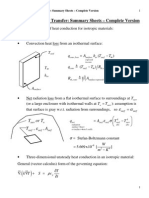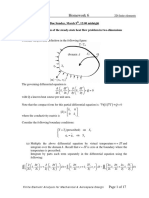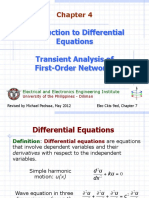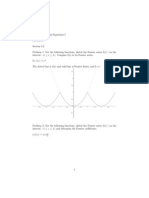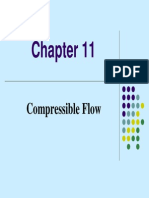Notes For Finite Element Method Thermal Analysis
Uploaded by
Manikanth ValavojuNotes For Finite Element Method Thermal Analysis
Uploaded by
Manikanth ValavojuM.
Vable
Notes for finite element method: Thermal Analysis
One-dimensional heat conduction
Axial Member Differential Equation d du EA = p x dx d x EA= Axial Rigidity px= force per unit length Heat Conduction d dT k = qx d x d x k= Thermal conductivity qx= Heat flow (source) per unit length. fx=heat flux per unit area= qxA T= Temperature dT dx Positive: Flow into body Heat Capacity: Heat flow: q = k 1 dT 2 - U T = -- k dx 2 dx
L L m
Primary variable Secondary variable Energy
u= Displacement in x-direction Internal axial force: N = EA Strain Energy: 1 du 2 U = -- EA dx d x 2
L
du dx
Work Potential:
L m
W A = p x u dx +
0
Fq u ( xq )
q=1
WT =
qx T dx + Qq T ( xq )
0 q=1
Functional
Potential Energy A = UA WA
n
T = UT WT
n
Rayleigh-Ritz u( x) = Matrix K jk Right Hand Side Vector
L
Ci fi ( x )
i=1
T(x) =
Ci fi ( x )
i=1 L
df j df k = EA dx d x d x
0 L m
K jk =
L
k d x d x dx
0 m
df j df k
Rj =
px fj
0
dx +
Fq fj ( xq )
q=1
R j = q x f j dx +
0
Qq fj ( xq )
q=1
Other Applications:
Flow through pipes; Flow through porous media; Electrostatics By non-dimensionalizing the problem a software can be used to solve all the above applications.
M. Vable
Notes for finite element method: Thermal Analysis
Linear Elements:
T = T1 L1 ( x ) + T2 L2 ( x ) [K
(e) (e) (e)
Q1
(e)
(e)
Q2
(e)
(e)
k ] = --------) 1 1 (e L 1 1
(e) (e)
{R
(e) (e) (e) qx L 1 Q1 } = ----------------- + 2 1 (e) Q 2 (e) (e) (e) fx L 1 Q1 } = ---------------- + A 2 1 Q( e ) 2
(e)
[K
(e)
k A ] = ------------------ 1 1 (e) 1 1 L
{R
(e)
Quadratic Elements:
T = T1 L1 ( x ) + T2 L2 ( x ) + T3 L3 ( x ) 7 8 1 k (e) [ K ] = ------------ 8 16 8 (e) 3L 1 8 7
(e) (e) (e) (e)
Q1
(e) (e)
Q3
(e) (e) 1 qx L
Q1 (e) { R } = ----------------- 4 + 0 6 (e) 1 Q3
Class Problem 1
Heat qo is being added at point B at a constant rate as shown in Fig. 1. Using two linear elements determine the temperature at point B and the heat flowing out at A and C in terms of k, L, and qo for the following two cases: (a) The ends of the bar are maintained at a constant zero temperature. (b) The ends of the bars are maintained at a constant temperature To.
qo A L B C 2L A L 3qo B L qo C L D
Fig .1
Fig .2
Home Problem 1
Heat 3qo is being added at point B and qo is being taken out at a constant rate at point C as shown in Fig. 2. Using three linear elements determine the temperature at points B and C and the heat flowing out at A and D in terms of k, L, and qo for the following two cases: (a) The ends of the bar are maintained at a constant zero temperature. (b) The ends of the bars A and D are maintained at a temperature To and 2To, respectively. ANS: TB = ( 5qo L ) 3k T C = ( q o L ) 3k q A = ( 5q o 3 )
M. Vable
Notes for finite element method: Thermal Analysis
Thermal Stresses
Stress-strain curve with temperature effects
Normal Stress
O T
O1
-E
Normal Strain
= -- + T = -- + o E E
where, = linear coefficient of thermal expansion. o = Initial strain= Thermal strain unconstrained body due to uniform temperature changes.
No thermal stresses are produced in a homogenous, isotropic,
Axial Problem
We assume that the thermal problem and stress analysis problem can be solved independently.
xx = E ( xx o )
L
U AT
1 = -- xx ( xx o ) dV = 2
V L L
-- E ( xx o ) 2
0 L
A dx or
L L
U AT
1 1 du 2 du 1 2 2 = -- EA xx dx EA xx o dx + -- EA o dx = -- EA dx EA o dx + U o d x d x 2 2 2
0 L 0 m 0 0 0
WA =
px ( x )u ( x ) dx + Fq u ( xq )
0 L q=1
A = U AT W A
1 du 2 du = -- EA dx EA o dx + U o d x d x 2
0 0
px ( x )u ( x ) dx + Fq u ( xq )
0 q=1
M. Vable
Notes for finite element method: Thermal Analysis
1 du 2 = -- EA dx + U o d x 2
0 L m
px ( x )u ( x ) dx + Fq u ( xq ) + EAo d x dx
du
0 L q=1 0
= U A W AT
W AT =
L
px ( x )u ( x ) dx + Fq u ( xq ) + EAo d x dx
du
0 q=1 L L 0 0
du I = EA o dx = EA o u ( x ) d x
0
d o EA u dx = EATu ( x ) dx
0 L
L L 0
d EA T u dx dx
0
EA dT I = EAT L u ( L ) EAT 0 u ( 0 ) + ----------- q x u dx , where q x = k k dx
0 L m
W AT =
[ px ( x ) + pxT ( x ) ]u ( x ) dx + Fq u ( xq ) + FT2 u ( L ) + FT1 u ( 0 )
0 q=1
where,
F T1 EAT 1 = F T2 EAT 2 qx = 0
EA p xT = ----------- q x k
Special case: Constant Temperature Change
T = Cons tan t
Thermal loads are added only at the element ends. Linear Element:
[K
(e)
EA ] = ------- 1 1 L 1 1
{R
(e)
(e) (e) p o L 1 p To L 1 F 1 F T1 } = -------- + ----------- + + 2 1 2 1 (e) (e) F 2 F T2
Quadratic Element:
(e)
[K
7 8 1 EA ] = ------- 8 16 8 3L 1 8 7
F(e ) 1 1 1 p o L p To L { R } = -------- 4 + ----------- 4 + 0 6 6 1 1 F(e ) 3
F( e ) T1 0 + F( e ) T3
M. Vable
Notes for finite element method: Thermal Analysis
Class Problem 2
Heat qo is being added at point B at a constant rate as shown in Fig. 3. Using two quadratic elements determine the displacement of node B, reaction force at A and the axial stress just before B in terms of E, A, , k, L, and qo. Assume that the entire bar was at zero temperature and the ends of the bars are maintained at zero temperature.
qo A L B C 2L A L 3qo B L qo C L D
Fig .3
Fig .4
Home Problem 2
Heat 3qo is being added at point B and qo is being taken out at a constant rate at point C as shown in Fig. 4. Using three linear elements determine the displacements of points B and C, the reaction force at A, and the axial stress just before B in terms of E, A, , k, L, and qo. Assume that the entire bar was at zero temperature and the ends of the bars are maintained at zero temperature. ANS: u B
5q o L = -----------------18k
2
uC
7q o L = -----------------18k
5EAq o L R A = -----------------------9k
M. Vable
Notes for finite element method: Thermal Analysis
2-D Steady State Thermal Analysis
Differential Equation:
T T k 2 + 2 = qv x y
2 2
or
k T = q v
Functional (Stored Heat):
UT = T T k x + y
2 2
t dx dy
where t= thickness of the body.
T T x x U T = [ k ] t dx dy T A T y y
T
Isotropic material:
[k] = k
---scaler quantity.
Element Approximation:
(e) T1 n T(e ) 2 (e) T ( x ) = T i f i ( x, y ) = f 1 f 2 f n i=1 (e) Tn
fi(x,y) are Lagrange Polynomials.
T f 1 f 2 x x x = T f 1 f 2 y y y f 3 f n x x f 3 f n y y (e) T1 (e) T2 (e) Tn (e) (e) = [B ]{d }
UT =
-- { d 2
(e) T
} [B
(e) T
] [k
(e)
][B
(e)
]{d
(e)
1 (e) T (e) (e) }t dx dy = -- { d } [ K T ] { d } 2
M. Vable
Notes for finite element method: Thermal Analysis
Element Conductivity Matrix
[ KT ] =
(e)
[B
A
(e) T
] [k
(e)
][B
(e)
]t dx dy
Heat Conduction Boundary Conditions
k T T T = k n x + n y = q n x n y
where,
n= direction of the unit normal to the boundary. nx, ny = direction cosines of the unit normal to the boundary. qn = specified heat flow in the n-direction on the boundary.
Right Hand Side Vector:
(e) { R } = qv (e) A f1 f2 t dx dy + q n (e) fn f1 f2 t ds fn
where,
= the boundary of the element. s= tangential coordinate along the element boundary.
T = h ( Tf T ) n
(e)
Convection Boundary Conditions
k
where,
h = convection heat transfer coefficients Tf = Temperature of the surrounding fluid h depends upon many factors: velocity of fluid, viscosity of fluid, density of fluid, and other properties of fluid. It also depends upon the surface roughness and surface geometry. Addition to Element Matrix: Addition to Element Right Hand Side Vector:
K ij = Ri
(e) (e)
(e)
f i f j t ds f i T f t ds
(e)
(e)
(e)
If
is an element boundary in the interior, then there is no convection there and hence no addition to the matrix or the element RHS vector.
(e)
M. Vable
Notes for finite element method: Thermal Analysis
Radiation Boundary Condition:
Heat radiated is proportional to the difference in the fourth power of temperature between the radiating bodies.
k T 4 4 = BC ( Tr T ) n
where,
BC is the proportionality constant. Tr is the temperature of the other radiating body. Temperatures Tr and T are in absolute degrees i.e., oK.
For two infinite parallel black bodies (planes) it is called the Boltzmann
constant. For regular bodies BC depends upon the emissivity of the bodies, the geometry and other factors. Radiation boundary conditions lead to non-linear thermal problem. A general approach is:
k T 2 2 = BC ( Tr + T ) ( Tr + T ) ( Tr T ) = hr ( Tr T ) n
In the iteration process, at each step treat the radiation boundary condition like a convection term with coefficient dependent upon the temperature at a particular step.
You might also like
- Computational Modelling of Steady Diffusion Process: Prof. Nilanjan Chakraborty E-MailNo ratings yetComputational Modelling of Steady Diffusion Process: Prof. Nilanjan Chakraborty E-Mail34 pages
- Conduction Heat Transfer:: Chap. 2: Advanced 1-D Analytical MethodNo ratings yetConduction Heat Transfer:: Chap. 2: Advanced 1-D Analytical Method17 pages
- The Non Linear Advection Equation (Inviscid Burgers Equation)No ratings yetThe Non Linear Advection Equation (Inviscid Burgers Equation)6 pages
- L7 - Engineering Method For Dynamic Aeroelasticity100% (1)L7 - Engineering Method For Dynamic Aeroelasticity19 pages
- Finite Element Method: Fem For Heat Transfer ProblemsNo ratings yetFinite Element Method: Fem For Heat Transfer Problems66 pages
- Chapter Five Phonons II. Thermal PropertiesNo ratings yetChapter Five Phonons II. Thermal Properties39 pages
- One-Dimensional Heat Conduction: Shape Functions and Node-Based FE-formulationNo ratings yetOne-Dimensional Heat Conduction: Shape Functions and Node-Based FE-formulation27 pages
- Rayleigh Flow - Thermodynamics: - Steady, 1-d, Constant Area, Inviscid Flow With No External Work ButNo ratings yetRayleigh Flow - Thermodynamics: - Steady, 1-d, Constant Area, Inviscid Flow With No External Work But10 pages
- UO2016F Slide 1 - Basic Relations and Equations of Heat ConductionNo ratings yetUO2016F Slide 1 - Basic Relations and Equations of Heat Conduction20 pages
- ME3122 Handbook of Heat Transfer Equations 2014No ratings yetME3122 Handbook of Heat Transfer Equations 201422 pages
- CHEE 405 (G) Process Heat Transfer: Chapter 2: 1-6No ratings yetCHEE 405 (G) Process Heat Transfer: Chapter 2: 1-620 pages
- Transient Conduction: Finite-Difference Equations and SolutionsNo ratings yetTransient Conduction: Finite-Difference Equations and Solutions17 pages
- Principles of Convection Heat Transfer by Sunny KumarNo ratings yetPrinciples of Convection Heat Transfer by Sunny Kumar12 pages
- Student Solutions Manual to Accompany Economic Dynamics in Discrete Time, secondeditionFrom EverandStudent Solutions Manual to Accompany Economic Dynamics in Discrete Time, secondedition4.5/5 (2)
- Logical progression of twelve double binary tables of physical-mathematical elements correlated with scientific-philosophical as well as metaphysical key concepts evidencing the dually four-dimensional basic structure of the universeFrom EverandLogical progression of twelve double binary tables of physical-mathematical elements correlated with scientific-philosophical as well as metaphysical key concepts evidencing the dually four-dimensional basic structure of the universeNo ratings yet
- Mathematics 1St First Order Linear Differential Equations 2Nd Second Order Linear Differential Equations Laplace Fourier Bessel MathematicsFrom EverandMathematics 1St First Order Linear Differential Equations 2Nd Second Order Linear Differential Equations Laplace Fourier Bessel MathematicsNo ratings yet
- Feynman Lectures Simplified 2C: Electromagnetism: in Relativity & in Dense MatterFrom EverandFeynman Lectures Simplified 2C: Electromagnetism: in Relativity & in Dense MatterNo ratings yet
- TEST 5: Measurement of Field Density by Sand Cone MethodNo ratings yetTEST 5: Measurement of Field Density by Sand Cone Method5 pages
- Astronomy 160: Frontiers and Controversies in Astrophysics Homework Set # 1 SolutionsNo ratings yetAstronomy 160: Frontiers and Controversies in Astrophysics Homework Set # 1 Solutions3 pages
- The Banach-Tarski Paradox: Zaichen Lu October 2009No ratings yetThe Banach-Tarski Paradox: Zaichen Lu October 200910 pages
- Mahakal Institute of Technology, Ujjain: Project:-Design of Prototype Solar Chimney PowerNo ratings yetMahakal Institute of Technology, Ujjain: Project:-Design of Prototype Solar Chimney Power22 pages
- Anodic Dissolution of Pure Aluminum During Electrocoagulation Process - Influence of Supporting Electrolyte, Initial PH, and Current Density PDF100% (1)Anodic Dissolution of Pure Aluminum During Electrocoagulation Process - Influence of Supporting Electrolyte, Initial PH, and Current Density PDF12 pages
- 05-3300-01-W-01-009 Pipeline Welding and NDT Spec (Onshore) Rev P2No ratings yet05-3300-01-W-01-009 Pipeline Welding and NDT Spec (Onshore) Rev P217 pages
- Predicting Crystallite Size of Mg-Ti-SiC Nanocomposites Using An Adaptive Neuro-Fuzzy Inference System Model Modified by Termite Life Cycle OptimizerNo ratings yetPredicting Crystallite Size of Mg-Ti-SiC Nanocomposites Using An Adaptive Neuro-Fuzzy Inference System Model Modified by Termite Life Cycle Optimizer16 pages
- The New Mercedes-Benz 4.0 L V8 Diesel EngineNo ratings yetThe New Mercedes-Benz 4.0 L V8 Diesel Engine4 pages
- Modeling and Analysis of Manufacturing SystemsNo ratings yetModeling and Analysis of Manufacturing Systems41 pages
- Computational Modelling of Steady Diffusion Process: Prof. Nilanjan Chakraborty E-MailComputational Modelling of Steady Diffusion Process: Prof. Nilanjan Chakraborty E-Mail
- Conduction Heat Transfer:: Chap. 2: Advanced 1-D Analytical MethodConduction Heat Transfer:: Chap. 2: Advanced 1-D Analytical Method
- The Non Linear Advection Equation (Inviscid Burgers Equation)The Non Linear Advection Equation (Inviscid Burgers Equation)
- L7 - Engineering Method For Dynamic AeroelasticityL7 - Engineering Method For Dynamic Aeroelasticity
- Finite Element Method: Fem For Heat Transfer ProblemsFinite Element Method: Fem For Heat Transfer Problems
- One-Dimensional Heat Conduction: Shape Functions and Node-Based FE-formulationOne-Dimensional Heat Conduction: Shape Functions and Node-Based FE-formulation
- Rayleigh Flow - Thermodynamics: - Steady, 1-d, Constant Area, Inviscid Flow With No External Work ButRayleigh Flow - Thermodynamics: - Steady, 1-d, Constant Area, Inviscid Flow With No External Work But
- UO2016F Slide 1 - Basic Relations and Equations of Heat ConductionUO2016F Slide 1 - Basic Relations and Equations of Heat Conduction
- CHEE 405 (G) Process Heat Transfer: Chapter 2: 1-6CHEE 405 (G) Process Heat Transfer: Chapter 2: 1-6
- Transient Conduction: Finite-Difference Equations and SolutionsTransient Conduction: Finite-Difference Equations and Solutions
- Principles of Convection Heat Transfer by Sunny KumarPrinciples of Convection Heat Transfer by Sunny Kumar
- Student Solutions Manual to Accompany Economic Dynamics in Discrete Time, secondeditionFrom EverandStudent Solutions Manual to Accompany Economic Dynamics in Discrete Time, secondedition
- Shortcuts to College Calculus Refreshment KitFrom EverandShortcuts to College Calculus Refreshment Kit
- Logical progression of twelve double binary tables of physical-mathematical elements correlated with scientific-philosophical as well as metaphysical key concepts evidencing the dually four-dimensional basic structure of the universeFrom EverandLogical progression of twelve double binary tables of physical-mathematical elements correlated with scientific-philosophical as well as metaphysical key concepts evidencing the dually four-dimensional basic structure of the universe
- Mathematics 1St First Order Linear Differential Equations 2Nd Second Order Linear Differential Equations Laplace Fourier Bessel MathematicsFrom EverandMathematics 1St First Order Linear Differential Equations 2Nd Second Order Linear Differential Equations Laplace Fourier Bessel Mathematics
- Feynman Lectures Simplified 2C: Electromagnetism: in Relativity & in Dense MatterFrom EverandFeynman Lectures Simplified 2C: Electromagnetism: in Relativity & in Dense Matter
- TEST 5: Measurement of Field Density by Sand Cone MethodTEST 5: Measurement of Field Density by Sand Cone Method
- Astronomy 160: Frontiers and Controversies in Astrophysics Homework Set # 1 SolutionsAstronomy 160: Frontiers and Controversies in Astrophysics Homework Set # 1 Solutions
- The Banach-Tarski Paradox: Zaichen Lu October 2009The Banach-Tarski Paradox: Zaichen Lu October 2009
- Mahakal Institute of Technology, Ujjain: Project:-Design of Prototype Solar Chimney PowerMahakal Institute of Technology, Ujjain: Project:-Design of Prototype Solar Chimney Power
- Anodic Dissolution of Pure Aluminum During Electrocoagulation Process - Influence of Supporting Electrolyte, Initial PH, and Current Density PDFAnodic Dissolution of Pure Aluminum During Electrocoagulation Process - Influence of Supporting Electrolyte, Initial PH, and Current Density PDF
- 05-3300-01-W-01-009 Pipeline Welding and NDT Spec (Onshore) Rev P205-3300-01-W-01-009 Pipeline Welding and NDT Spec (Onshore) Rev P2
- Predicting Crystallite Size of Mg-Ti-SiC Nanocomposites Using An Adaptive Neuro-Fuzzy Inference System Model Modified by Termite Life Cycle OptimizerPredicting Crystallite Size of Mg-Ti-SiC Nanocomposites Using An Adaptive Neuro-Fuzzy Inference System Model Modified by Termite Life Cycle Optimizer





